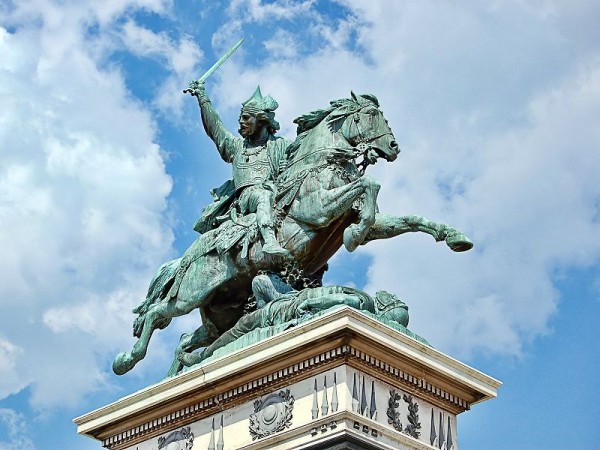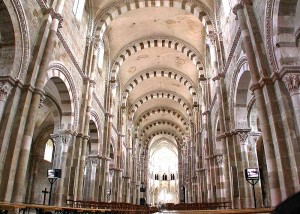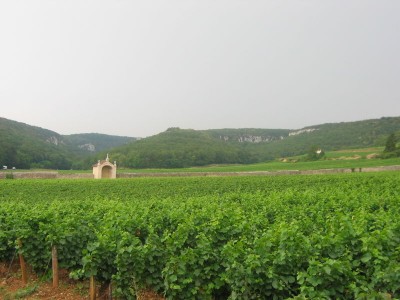 In no other part of the world does a mix of history, romantic legend, factors of geology, and a curious genetic quality for maximizing quality of life come together as it does in France. Though fitted with spectacular alpine peaks and thousands of kilometers of picturesque seascape, it is the center core of less spectacular landscape that carries the real mystique. The temperate part of the planet is full of nondescript rolling hills and rock outcroppings, but leave it to the French to create from a querky ridge of metamorphic limestone known as the Cote de ‘Or, a wonderful tapestry of heroes, stories, legends and magnificent wines that make the region of the Bourgogne famous the world over. The tapestry is of Roman proconsuls and barbarian kings, the bones of pilgrimage and Benedictine monks, engineers and future French presidents, even rampaging wolves, and they all have their story, but perhaps it can be simplified in saying at a base level they all came for the grapes. Those special grapes of Pinot and Chardonnay that reach their zenith on the limestone bluffs beyond the towns of Chablis, Chambertin, Beaune, and Nuits St Georges make for some of the greatest wine in the world, and bring us to look in wonder at the characters that were drawn by their allure.
In no other part of the world does a mix of history, romantic legend, factors of geology, and a curious genetic quality for maximizing quality of life come together as it does in France. Though fitted with spectacular alpine peaks and thousands of kilometers of picturesque seascape, it is the center core of less spectacular landscape that carries the real mystique. The temperate part of the planet is full of nondescript rolling hills and rock outcroppings, but leave it to the French to create from a querky ridge of metamorphic limestone known as the Cote de ‘Or, a wonderful tapestry of heroes, stories, legends and magnificent wines that make the region of the Bourgogne famous the world over. The tapestry is of Roman proconsuls and barbarian kings, the bones of pilgrimage and Benedictine monks, engineers and future French presidents, even rampaging wolves, and they all have their story, but perhaps it can be simplified in saying at a base level they all came for the grapes. Those special grapes of Pinot and Chardonnay that reach their zenith on the limestone bluffs beyond the towns of Chablis, Chambertin, Beaune, and Nuits St Georges make for some of the greatest wine in the world, and bring us to look in wonder at the characters that were drawn by their allure.
The first recorded burgundian wine interloper happened to write an excellent travelogue of his experiences, and from which we draw our first acknowledgement of the region. Our author was none other than Gaius Julius Caesar, who in his epic Commentaries on the Gallic Wars introduces us to our first local hero, Vercingetorix, leader of the local tribes of Gaul. The Gaul of Roman times was already known for its wine crop when Caesar decided to make his mark in history(and expand his bank account) by subduing the tribes of Gaul. Vercingetorix was more noble than barbarian, but for the haunty Romans, apparently a man much in need of subjugation. Vercingetorix as heroes go was not exactly a humane figure, but rather crafty and violent Celtic leader of the Avernii tribe that fought Caesar to a draw on several occasions before meeting his final defeat at Alesia just outside the modern burgundian town of Alise Sainte-Reine, in 52 BC . There was no doubt much burgundian wine consumed by Caesar and his legions as the brought the captured Vercingetorix back to Rome for public humiliation, imprisonment, and in due time, death by strangulation. To the locals of Burgundy who still see themselves as Aedui, the original inhabitants of the Cote de ‘Or, Vercingetorix is the triumphant hero of the region, and perhaps the first historical French resistor.
The Romans having finally successfully subdued the Celts, converted the celtic lands into the Roman Provence of Gaulus Lungdenesis, and contributed to the agricultural development of the wine crop with high demand for drink, excellent ramrod straight roads like the Via Agrippa for transport of goods, and relative peace. Nothing lasts forever and that was certainly true of Pax Romana. Half a century later and it was the “barbarians” that returned the favor on Rome, sacking it, it making wine once again a local product. It was left to the successor to Roman empire building, the administration of the Christian church, to bring the area back to prominence as a nursery for leaders. the Benedictines founded one of their great abbeys in Vezelay, and wine is a tonic for all great meditation.  The town became a mecca for pilgrims who sought to begin their great pilgrimage on the way of Saint James, and to get close to the bones of Mary Magdelene herself, said to be housed as relics in the cathedral at Vezelay. The fact that this was only one of several churches holding the so called remains of Mary, required Pope Stephan IX in 1058 to declare the Vezelay relics as the genuine article, making the little town in Burgundy a center for visitors from all over Europe. The popularity made the local dukes very rich and very powerful, and the Dukes of Burgundy, ruling from Dijon, became important rivals of the House of Valois for the French throne, stopped only by their lack of fecundity leaving the Duchy without an heir, absorbed in the fifteenth century into the greater kingdom of France. The house of Valois had their Bordeaux and Loire valley wines but nothing quite like the chardonnay and pinot of the Burgundians, thus completing the greatness of the French Kingdom.
The town became a mecca for pilgrims who sought to begin their great pilgrimage on the way of Saint James, and to get close to the bones of Mary Magdelene herself, said to be housed as relics in the cathedral at Vezelay. The fact that this was only one of several churches holding the so called remains of Mary, required Pope Stephan IX in 1058 to declare the Vezelay relics as the genuine article, making the little town in Burgundy a center for visitors from all over Europe. The popularity made the local dukes very rich and very powerful, and the Dukes of Burgundy, ruling from Dijon, became important rivals of the House of Valois for the French throne, stopped only by their lack of fecundity leaving the Duchy without an heir, absorbed in the fifteenth century into the greater kingdom of France. The house of Valois had their Bordeaux and Loire valley wines but nothing quite like the chardonnay and pinot of the Burgundians, thus completing the greatness of the French Kingdom.
As Paris progressively became the center of French power and prestige, the homeland of Vercingetorix concentrated on exploiting the the encarpment of limestone but still occasionally contributed to French civilization with great engineers like Gustave Eiffel, Dominique Denon, developer of the Louvre Museum, and Francois Mitterand, mayor of Chateau Chinon (Ville) , parttime Vichi collaborator and French resistor, and later, President of France. Well, maybe I should have stopped with Denon, as Mitterand was not a Burgundy native and definitely not Aedui.
The nineteenth and twentieth centuries saw the little towns of Burgundy take full advantage of the unique terrior and create some world famous vintages of their special grapes, bringing the Pinot Noir of Gevrey Chambertin and Nuits St Georges and the Chablis of Les Preuses and Blanchot, and the Chardonnays of Montrachet to the pinnacle of world prominence and wine excellence. I had the occasion to drink a young 2009 Gevrey Chambertin last night, full of flavor to the point of being slightly tart, but already showing the finesse known for burgundy Pinot Noir. It set off the lamb chop rosemary sweetness perfectly and made me go home and order some more as well as a few Nuits St Georges for my more economical nights of relaxation.
And so with all the history we’ve reviewed, where do the drunken wolves come in? Well, World War II legend has it that the war made the towns and chateaus of Burgundy so devoid of people that food was scarce and the wine crops undefended, resulting in hungry wolves from the countryside forests seeking any food they could find feasting on the fermenting grapes, and sauntered into the towns drunk . Laying around burgundian towns drunk without a care in the world, they met their maker, as the horrified town residents found their presence, drunk and docile as they were, unacceptable. To this day, one can understand, that there is little sympathy and consolation for those who would drink and travel, regardless of the context. Loving the Gevrey Chambertin as I did, and wolfishly devouring the bottle, I made sure to have someone else drive me home, so as not to meet the fate of those poor drunken wolves, and miss out the next time I experienced the greatness of the wines of Burgundy.

